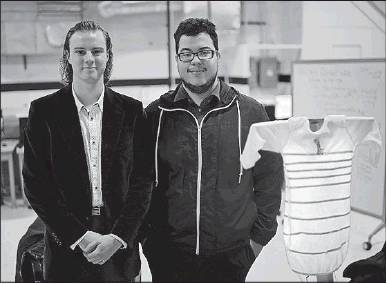COLLEGES
Clothing you can feel good about at URI
Student-designed garments offer biomedical benefits
By G. Wayne Miller Journal Staff Writer
SOUTH KINGSTOWN — A class taught by a University of Rhode Island professor of biomedical engineering has inspired students to design new so-called wearable technologies that can help jaundiced babies and people living with diabetes, the university reports.
James Baez, of Providence, and Joshua Harper of Gray, Maine, designed a onesie for jaundiced newborns through the class titled The Wearable Internet of Things, taught by professor Kunal Mankodiya, who also is director of URI’s Wearable Biosensing Laboratory.
“We think our project fills the gap where other treatments have fallen short,” Harper said. “We’re excited about its potential.”
Typically caused by liver problems, jaundice is the yellowing of eyes and skin caused by overproduction of bilirubin, which is excreted by the organ. Light therapy can break down bilirubin, but existing treatments have drawbacks.
For the class, Harper and Baez designed their Jaundice Suit, or J-Suit, which provides superior light-therapy treatment, according to the school.
“The J-Suit contains hundreds of Light Emitting Diodes, or LEDs,” URI said. “The clothing is designed with wireless connectivity that allows a smartphone to control the LEDs remotely and collect data for parents and doctors to track the baby’s progress.”
In another project, Gregory D’Ambrosca, of West Warwick, and Aaron Gilmore, of Barrington, designed wearable socks that stimulate blood flow for diabetics with disease-related ulcers of the feet and lower legs. Exercise can ease these symptoms, but older people may not always walk sufficiently to provide the benefit, the school said.
“We created wearable socks that give foot massages to patients who are unable to move much,” says Gilmore. “A microcontroller mounted to the sock is paired with an accelerometer and three vibration actuators which are similar to the ones found in cellphones. When the accelerometer detects no motion, vibration actuators activate in a downward motion. This mimics a massage by pushing blood downward toward the toes to stimulate blood flow.”
Other projects were completed by Mary Ellen Sweeney, Tian Chen, and Scott Barlow (a “Bionic Hand” to help stroke patients regain finger movement); Nathan Ankomah-Mensah, Sawyer Nichols and Zachary Silveira (a device measuring ultraviolet rays that could help prevent sunburn); and Ryan Ivone and Matt Cohen (a “smart” water bottle).
“The class gave us an exciting chance to bring to life our own innovations,” says Nichols. “What makes Professor Mankodiya’s course so unique is the entrepreneurial approach. It’s an awesome opportunity for engineering undergraduates, with applications to the world.”
“Our students are designing incredible wearable technologies,” says Mankodiya. “I’m privileged to guide them along and help them flourish.”
